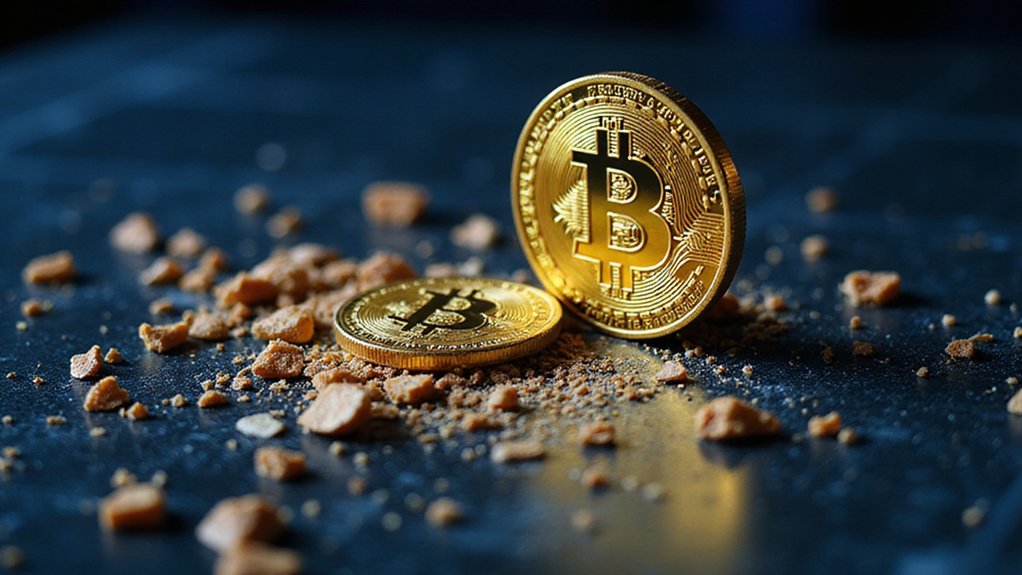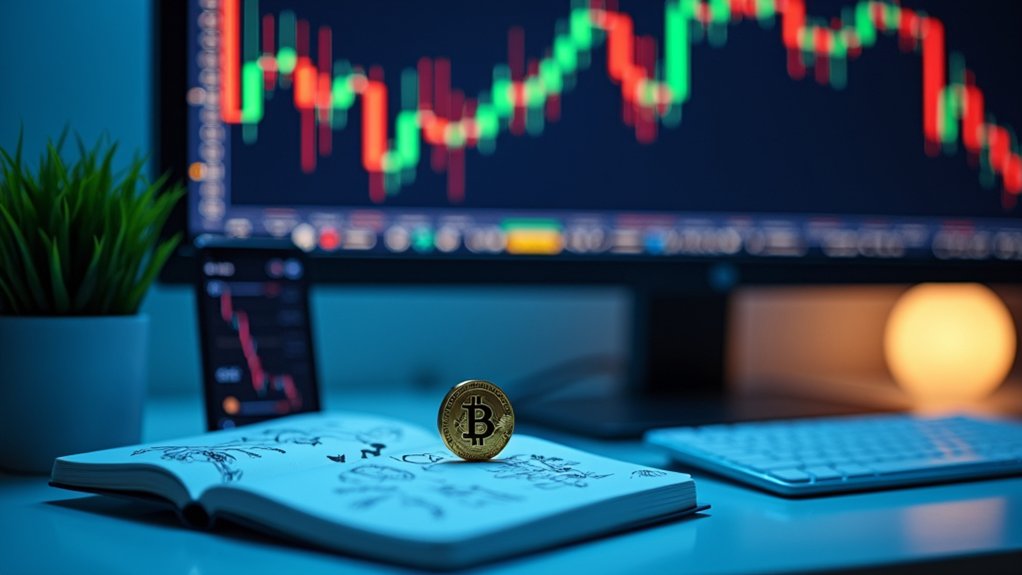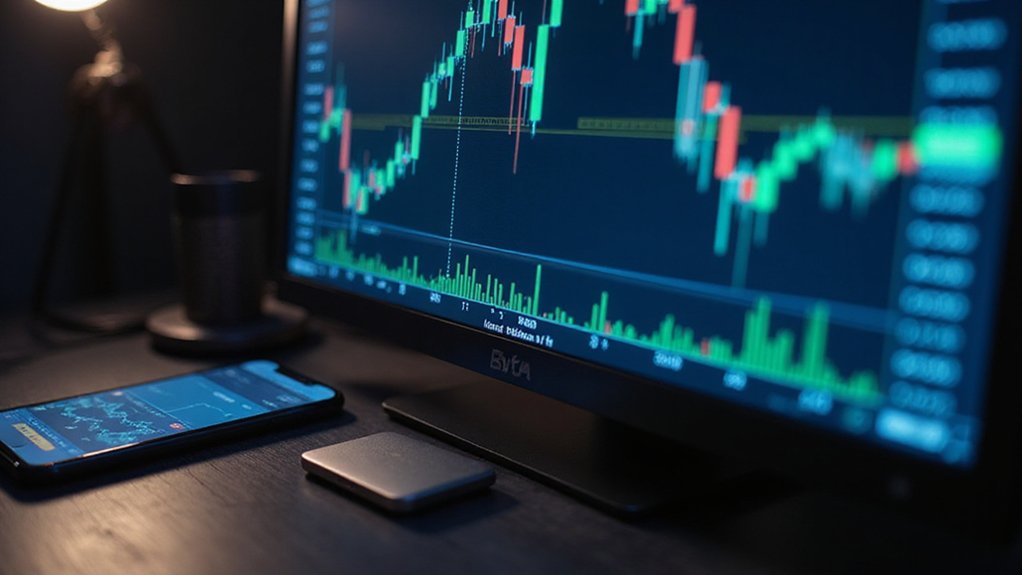A satoshi, Bitcoin’s smallest unit (one hundred millionth of a BTC), trades at approximately $0.000855 as of April 2025. Currently sitting 45.91% below its all-time high of $0.0004836, this microscopic denomination exhibits remarkable volatility—fluctuating over 50% within 30-day periods. Analysts project values ranging from $0.000009334 to $0.0003247 for 2025, with mid-May forecasts suggesting a potential 225% surge. The humble satoshi, essential for microtransactions, contains multitudes beneath its decimal-heavy façade.

Just how valuable is the smallest unit of Bitcoin in today’s volatile cryptocurrency market?
As of April 2025, a single Satoshi (SATS) token—named after Bitcoin’s enigmatic creator—trades at approximately $0.000855, a figure that simultaneously represents both microscopic value and extraordinary potential.
This fractional denomination, despite its decimal-heavy price point, has captured the imagination of investors seeking the next astronomical return in crypto’s perpetually turbulent landscape.
Price forecasts for SATS reveal a striking divergence of opinion among analysts, with some projecting a surge to $0.00061234 by mid-May 2025—a 225% increase that would transform a modest $1,000 investment into a $3,600+ windfall (fees notwithstanding).
Analysts’ wildly divergent SATS forecasts promise either spectacular returns or sobering losses in crypto’s perpetual uncertainty theater.
Other prognosticators offer more tempered expectations, suggesting a 2025 peak of $0.0003247 against a potential floor of $0.000009334.
Long-term projections extend this uncertainty further, with 2050 valuations ranging between $0.000001542 and $0.002552—a spread that elegantly encapsulates the speculative nature of cryptocurrency investing.
The token’s market behavior exhibits classical high-volatility characteristics, with 30-day fluctuations exceeding 50% and a rather anemic 37% of trading days registering positive movements.
Technical indicators present a mixed narrative; the price maintains position above the 200-day moving average while struggling beneath the 50-day benchmark, and an RSI of 23.07 suggests the asset may be approaching oversold territory.
Critical for potential investors is the distinction between the SATS token and its namesake variant, the Satoshi Nakamoto token, which commands substantially higher valuations between $0.18 and $3.90.
This nomenclature confusion—not uncommon in cryptocurrency markets—underscores the importance of meticulous research before capital deployment.
Each satoshi represents exactly one hundred millionth of a bitcoin (0.00000001 BTC), making these fractional units essential for facilitating microtransactions as Bitcoin’s value increases.
Ultimately, Satoshis represent both the minutiae of Bitcoin’s architecture and the broader paradox of cryptocurrency valuation: microscopic units with potentially macroscopic returns, though always accompanied by the specter of equally substantial losses. The current market data indicates a significant all-time-high of $0.0004836, representing potential for recovery given the current price is 45.91% below this peak. The recent 6-month change of -49.47% further illustrates the dramatic volatility inherent in this asset class.
The question remains whether these digital fragments will solidify into substantial value or dissolve into the ether of failed financial experiments.
Frequently Asked Questions
How Do I Buy Satoshis on Cryptocurrency Exchanges?
To buy satoshis on cryptocurrency exchanges, investors must first create and verify an account on platforms like Binance, KuCoin, or Kraken.
After depositing funds via bank transfer or card, they can purchase SATS directly through trading pairs (typically SATS/USDT).
Alternatively, one might need to buy Bitcoin first, then acquire satoshis as fractional BTC units.
Post-purchase, transferring assets to a secure hardware wallet—rather than leaving them vulnerable on exchanges—remains prudent for long-term holders.
Can Satoshis Be Converted to Physical Cash?
Yes, satoshis can be converted to physical cash through several methods, though the process isn’t direct.
Users typically convert satoshis to bitcoin first, then access cash via Bitcoin ATMs (albeit with hefty fees), crypto debit cards at conventional ATMs, or by selling on exchanges with subsequent bank withdrawals.
Peer-to-peer platforms also facilitate in-person cash trades—a throwback to traditional commerce in our increasingly digital economy.
The conversion path ultimately depends on one’s jurisdiction and tolerance for transaction costs.
What Wallets Are Best for Storing Small Amounts of Satoshis?
For small amounts of satoshis, Lightning Network-enabled mobile wallets offer the ideal blend of convenience and utility.
Wallet of Satoshi stands out for sheer simplicity—ideal for crypto novices—while Breez and Phoenix provide more control without sacrificing usability.
Those seeking stronger security might pair a hardware wallet (Ledger Nano X or Trezor) with Lightning capabilities.
The choice ultimately hinges on one’s preferred balance between ease-of-use and security—custodial solutions trading convenience for control.
How Are Satoshi Transaction Fees Calculated?
Satoshi transaction fees are calculated based on the data size (in virtual bytes) of the transaction multiplied by the fee rate (in sat/vB).
Unlike percentage-based systems, Bitcoin’s fee mechanism depends entirely on transaction complexity—more inputs and outputs mean larger transactions requiring higher fees.
During network congestion, users compete for limited block space, creating a dynamic fee market where miners prioritize transactions offering higher fees relative to their size.
Smart users monitor the mempool to time transactions during periods of lower demand.
Will Satoshis Become the Standard Unit for Bitcoin Transactions?
Satoshis are increasingly positioned to become the standard unit for Bitcoin transactions, particularly as BTC’s value climbs to levels where decimal-heavy denominations become cognitively unwieldy.
The trend is evident in wallet interfaces, exchange displays, and Lightning Network implementations—all gravitating toward sats-based accounting.
While traditionalists cling to whole Bitcoin measurements, the psychological advantage of working with whole numbers rather than fractional decimals makes satoshi standardization seemingly inevitable, despite the remaining hurdles in universal adoption and educational awareness.









